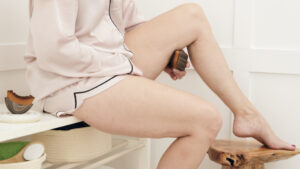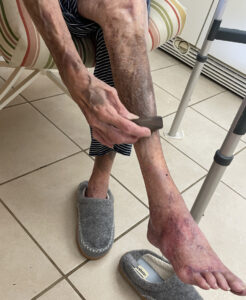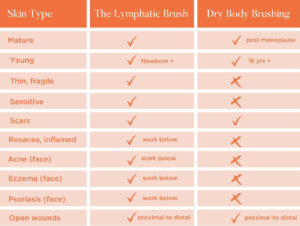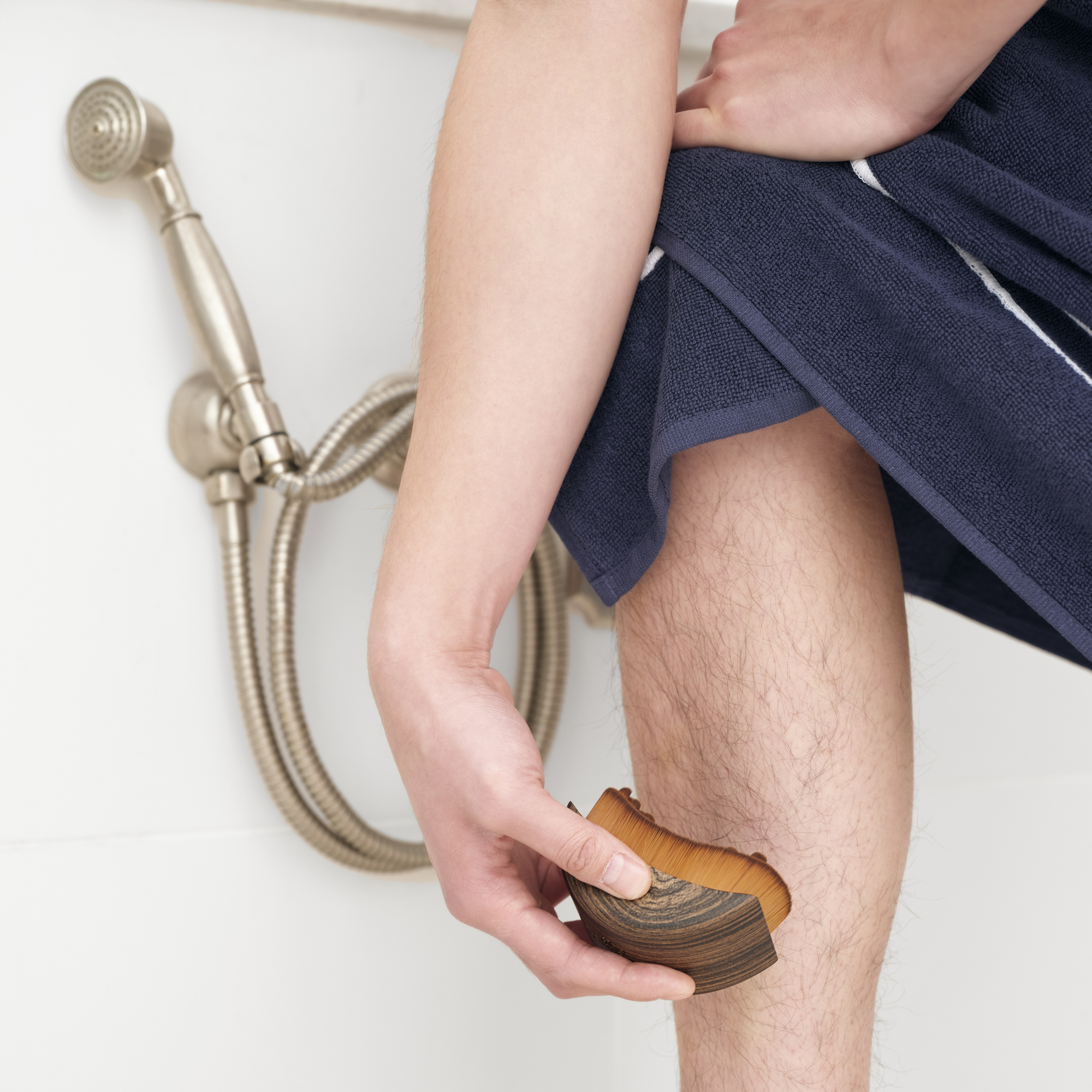By Ashley Jo Press, ASTECC | Dr. Vodder Certified Instructor
As a Dr. Vodder Certified MLD Educator, I have always stressed the importance of dry brushing to help keep fluids moving and support the body’s overall health. Over the last 20 years, dry body brushing (DBB) has always been my “go to” tool to help stimulate my lymphatic system and that of my clients.
However, dry brushing isn’t for everyone. I consistently receive pushback about how rough and painful the bristles are and that it can only be used periodically, or not at all.
Until recently, with the introduction of The Lymphatic Brush (TLB), there just wasn’t another option on the market. When I first used it, I found it solved many of the problems with dry brushing.
 Although used in a similar manner, dry brushing is a separate treatment modality with some distinctive intentions and goals that differ from manual lymphatic drainage. It’s your intention and goal that affect how you use each of the brushes. Let’s explore!
Although used in a similar manner, dry brushing is a separate treatment modality with some distinctive intentions and goals that differ from manual lymphatic drainage. It’s your intention and goal that affect how you use each of the brushes. Let’s explore!
Why is this important?
The lymphatic system is where your body’s natural filtration occurs, so whether you have a comprised system or not, it’s beneficial to give it a little nudge from time to time to keep things flowing.
The lymphatic system pumps 2 liters of fluid to the heart every 24 hours and ensures that all the dead cell matter, proteins, fats, and most of the water that goes into the tissues is delivered to the lymph nodes to be repurposed, processed, or redistributed.
It is also responsible for transporting a steady supply of white blood cells throughout the body to ensure our defenses against pathogens and free radicals remain strong, thus creating immunity.
It maintains the fluid pressure in the circulatory system by returning proteins and water to the blood. Of all the water taken into the lymph node, up to 50% is returned to the venous system after it has been clean and purified.
This life-sustaining process and the ability of our lymphatic system to keep things propelling forward is essential for our internal health and the overall functioning of all systems.
Without it, stagnation will occur, which may lead to a feeling of heaviness, experiencing puffiness (eyes, chin, ears, gut), pain, lowered immune functioning or more chronic inflammatory and detrimental health conditions.
Cosmetically speaking, inflammation is the pre-cursor to aging, so the better things are flowing on the inside, the healthier our skin will appear on the outside. And who doesn’t want to look and feel their best?
What’s the difference?
Although used in a similar manner, dry brushing is a separate treatment modality with some distinctive intentions and goals that differ from manual lymphatic drainage using TLB.
 The Bristles: Structure and Function
The Bristles: Structure and Function
The bristles on dry brushes are much firmer and meant to be used in quick strokes over a short period to create a slight hyperemia (reddening of the skin) to stimulate circulation and the lymphatic system simultaneously.
The true purpose behind the dry brushing is to relieve congestion in the tissues and keep the fluid from getting stagnant, along with the added benefit of skin exfoliation.
In contrast, TLB has soft bristles that are designed with a specific density and texture to grip the skin and move it without causing any friction, or hyperemia (redness).
The gentle nature of TLB allows for frequent and longer periods of use, without affecting the circulatory system. This creates the space necessary for maximum drainage of the tissues. It also provides a mild exfoliation, removing only the skin cells that are ready to shed naturally.
Daily use of a dry brush can help the skin feel softer due to the firm bristles. If you’re able to withstand the abrasiveness, I’ve found it to be a stimulating way to start the day. I suggest dry brushing in the morning after you shower, on dry skin, to create a full-body wake-up on the inside and outside. It’s better than coffee.
Alternately, you can use TLB in a similar fashion after you shower, to gently move excess fluids and waste out of the tissue, reduce puffiness and inflammation.
Contrast & Comparison
Sensitive | Thin Skin
Those with sensitive and thin skin are not able to use even the softest dry body brushes because they are too abrasive, or painfully irritating.
The Lymphatic Brush is excellent for all skin types and provides two bristles options; body (shorter bristle, soft, firm) and facial (longer bristle, soft, wispy). For elderly, crepey skin, the facial brush is recommended to avoid risk of tearing.
Frequency of Use
Although the bristles on TLB Face and Body are slightly different, they can be used interchangeably. When dry brushing, it’s important to use a separate dry brush for the face as the bristles are softer.
Additionally, unlike a dry brush, TLB can be used with prolonged and repetitive use on the same area without discomfort or damaging the skin. It’s more relaxing, feels pleasant and comforting to the skin.
Skin Types & Indications
 Dry brushing is not for everyone, or all skin types and ages due to its abrasiveness and stimulating nature. It should be done after a shower on dry skin.
Dry brushing is not for everyone, or all skin types and ages due to its abrasiveness and stimulating nature. It should be done after a shower on dry skin.
TLB is suitable for everyone , all skin types and ages, and can be used any time of day since it isn’t simulating and doesn’t cause irritation to the skin
Do not brush on open wounds. For acne, eczema, or inflamed pustules on the face, work below and focus on the neck. For eczema and/or psoriasis on the body, work proximal to distal (away from the affected area) and focus on opening the closest group of nodes primal to the wound or skin irritation.
Be mindful that skin thins as we age, so use caution when dry brushing mature (post-menopausal) skin and discontinue if you feel any discomfort. There is no age limit for TLB. For elderly, or anyone with extremely fragile skin, use The Lymphatic Brush (Face).
Cosmetic Benefits | Personal and Professional
Dry brushing and TLB are both effective tools to incorporate into your personal or professional skin and body care practices, but it’s important to keep their differences in mind when seeking a treatment that meet your needs.
- The Lymphatic Brush is intended solely for drainage and deliberately used to calm the nervous system, reduce inflammation, and clear waste within the tissue to make space for the nutrient and oxygen rich blood to reach the cells.
- A dry body brush is intended solely to stimulate, and deliberately used to increase circulation and bring a fresh supply of nutrient and oxygen rich blood into the tissue to nourish the cells. This subsequently, stimulates the flow of lymph through the lymphatic vessels.
Dry brushing and manual lymphatic drainage can be used independently, combined into a single session (with dry brushing done first), or alternating on different days depending on your needs or mood.
If consistency is key, TLB increases the probability of more frequent use due to its flexibility and unique ability to “grip” the skin in a particular way that allows you to immediately see and feel the effects as you work.
Movement is life, stagnation is death.
It’s crucial to the health of your skin to move daily whether through manual lymphatic drainage, dry brushing, exercise, or deep breathing.



